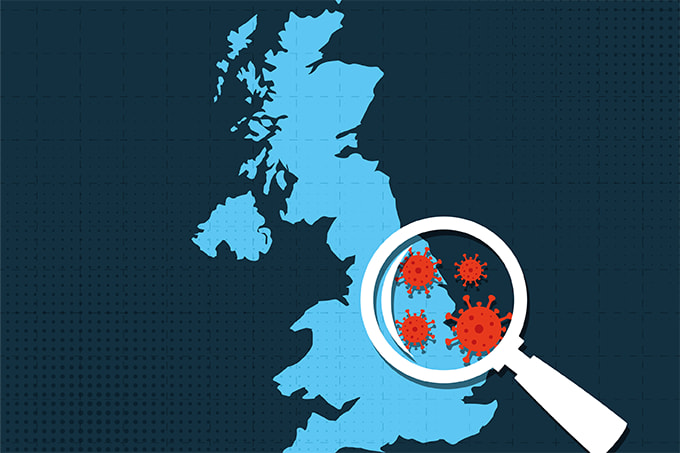Accelerating effects of climate change aren’t just impacting the environment – it’s also a public health threat, driving the spread of infectious disease. We connected with Ephraim Tsalik, Vice President and Chief Scientific Officer of Infectious Disease and Acute Care at Danaher Diagnostics, to discuss the growing risk of disease and how innovation in diagnostics and disease surveillance is essential for strengthening healthcare resilience.

How is climate change currently shaping the global burden of infectious diseases?
The emergence, re-emergence, and spread of infectious disease stems from a highly complex interaction between microbial evolution and civilization. Widespread antibiotic use fuels antimicrobial resistance. Global travel enables rapid spread of disease. Human–animal co-location enables zoonotic spread.
However, climate change may be the most complex variable shaping the global burden of infectious disease. Warming temperatures change the geographic distribution of pathogens and their vectors. Droughts can drive animals closer to inhabited areas and increase the risk of zoonotic transmission. Storms and floods increase the risk of waterborne diseases as people are displaced amid disruptions to healthcare infrastructure. It is safe to assume that the overall burden of infectious disease will increase due to climate change.
What shifts in disease patterns are you most concerned about from a diagnostics perspective?
In any given region, clinicians grow familiar with the infectious diseases that most commonly affect their patients. For example, a tick bite in the US Northeast typically raises concern for Lyme disease, while here in North Carolina, we’re more attuned to Rocky Mountain spotted fever. In tropical areas, clinicians are well-versed in illnesses like dengue, leptospirosis, malaria, and chikungunya – diseases that most US providers rarely, if ever, encounter.
Across these regions, we learn to use the diagnostic tools suited to the infections we routinely manage. But as disease patterns shift due to changing climates, clinicians everywhere will need to broaden their differential diagnoses. To support accurate decision-making, access to a wider range of diagnostic tests will become increasingly important.
Among all the expected impacts of climate change, the one that concerns me most is the expansion of vector-borne diseases into new territories. Mosquitoes and ticks carry many pathogens with overlapping symptoms, making diagnosis challenging. Beyond the rising burden of disease, I worry about the diagnostic uncertainty clinicians will face. Without access to the appropriate tests, treatment will often be empiric – and potentially mismatched to the actual infection.
What are the emerging diagnostic needs related to climate-sensitive conditions?
Emerging infectious disease threats span multiple domains: vector-borne, waterborne, and respiratory. To effectively respond, we must ensure that diagnostic tests are available to cover the full spectrum of diseases expected to become more prevalent.
This will require a broad range of diagnostic tools, including culture methods, serology and immunoassays, PCR, and sequencing. Ideally, these tests should be available at the point of need to maximize clinical impact. That means they must be accessible where patients receive care, not reliant on specialized laboratories or highly trained personnel, and free from the delays associated with send-out testing.
Which regions are likely to experience the most significant diagnostic and surveillance gaps as climate-related health risks grow – and how can the diagnostics industry help close them?
No region will be immune to the impact of climate change on infectious disease. It’s not a question of if, but when and how severe it will be. However, the effects will be felt most acutely in areas with limited diagnostic and surveillance capacity, often due to resource constraints. These same regions frequently lack the infrastructure to support public and individual health beyond the hospital or clinic – raising questions like: Can patients reach care? Do clinicians have access to the tests they need? Are effective treatments available?
While the diagnostics industry can't solve every challenge, it plays a vital role. It must prioritize tests that are accessible at the point of need – simple to use, easy to interpret, and capable of delivering fast, actionable results. These diagnostics should align with the local disease burden and be affordable to ensure they reach the populations who need them most.
What role do rapid diagnostics play in early containment and management?
We’ve repeatedly seen how quickly infectious diseases can spread. But containment and management are impossible without first identifying who is infected and potentially transmitting the disease. Given how brief most patient encounters are, fast and reliable diagnostics are essential.
While isolating suspected cases during testing may work in rare outbreaks – like Ebola in 2014 – this strategy isn’t feasible when infections become widespread. Even the most advanced health systems can’t maintain mass quarantines.
“Rapid diagnostics” should also mean rapid development of diagnostics. Companies must act swiftly to design, validate, and produce tests for emerging threats. At the same time, governments and regulators should streamline approval pathways – ensuring both speed and quality in the rollout of new diagnostic tools.
How can real-time diagnostic data be better integrated into public health systems to support early warning and rapid response to outbreaks worsened by climate change?
This kind of integration needs to occur at multiple levels. Sharing public health and surveillance data across borders – whether county, state, or national – can provide a clearer picture of where diseases are today compared to one, five, or ten years ago. Recognizing these trends is essential for raising awareness and preparing effective responses.
In addition to linking surveillance systems, we should aim to harness data from the many diagnostic tests already used in routine clinical care. While the diversity of tests and lack of standardized reporting make this a challenging task, emerging tools like artificial intelligence offer promising solutions. AI can help bridge these differences, detect patterns, and generate early warnings that support proactive public health action.
What advances in diagnostic technology are you most excited about in terms of combating climate-sensitive disease threats?
I may be a bit biased, but PCR offers many valuable advantages. It’s fast, highly sensitive and specific, cost-effective, widely available in healthcare settings, and flexible enough to support high-multiplex syndromic testing. PCR assays can also be developed quickly in response to emerging threats, and the menu of detectable pathogens continues to expand – making it a strong candidate to meet future diagnostic demands.
I'm also excited about sequencing technologies, which are becoming faster and more affordable. While current logistics limit sequencing to specialized laboratories, I’m optimistic that ongoing innovations will make it more accessible at the point of need in the near future.
What does the future hold – how do you think we’ll be holding up a decade from now?
From a climate change perspective, unfortunately, we are likely to face the same challenges – or worse – in the years ahead. As a result, current trends in the emergence, re-emergence, and spread of infectious diseases will continue, and may even accelerate. While many (though not all) countries and regions will improve their healthcare infrastructure to better leverage diagnostic testing, much work remains.
The coming decade presents both an opportunity and a responsibility to prepare. This includes expanding the diversity of available tests, which in turn should drive greater utilization to help mitigate infectious disease at both individual and population levels. Thankfully, new technologies are on the horizon that promise to democratize access to testing – including data-rich approaches, such as sequencing.




